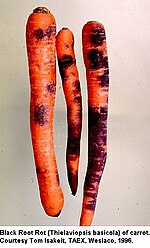| Thielaviopsis basicola | |
|---|---|

| |
| Microscopic view of Thielaviopsis chlamydospores (black) and endoconidia (hyaline) | |
| Scientific classification | |
| Domain: | Eukaryota |
| Kingdom: | Fungi |
| Division: | Ascomycota |
| Class: | Sordariomycetes |
| Order: | Microascales |
| Family: | Ceratocystidaceae |
| Genus: | Thielaviopsis |
| Species: | T. basicola
|
| Binomial name | |
| Thielaviopsis basicola (Berk. & Broome) Ferraris (1912)
| |
| Synonyms | |
|
Chalara elegans Nag Raj & W.B. Kendr. (1975) | |
Thielaviopsis basicola is the plant-pathogen fungus responsible for black root rot disease. This particular disease has a large host range, affecting woody ornamentals, herbaceous ornamentals, agronomic crops, and even vegetable crops.[citation needed] Examples of susceptible hosts include petunia, pansy, poinsettia, tobacco, cotton, carrot, lettuce, tomato, and others.[citation needed][1] Symptoms of this disease resemble nutrient deficiency[citation needed] but are truly a result of the decaying root systems of plants.[citation needed] Common symptoms include chlorotic lower foliage, yellowing of plant, stunting or wilting, and black lesions along the roots.[1][citation needed] The lesions along the roots may appear red at first, getting darker and turning black as the disease progresses. Black root lesions that begin in the middle of a root can also spread further along the roots in either direction. Due to the nature of the pathogen, the disease can easily be identified by the black lesions along the roots, especially when compared to healthy roots.[citation needed] The black lesions that appear along the roots are a result of the formation of chlamydospores, resting spores of the fungus that contribute to its pathogenicity. The chlamydospores are a dark brown-black color and cause the "discoloration" of the roots when they are produced in large amounts.[2]

- ^ a b Coumans, J. V. F.; Harvey, J.; Backhouse, D.; Poljak, A.; Raftery, M. J.; Nehl, D.; Katz, M. E.; Pereg, L. (March 2011). "Proteomic assessment of host-associated microevolution in the fungus Thielaviopsis basicola: Australian diversity of Thielaviopsis basicola". Environmental Microbiology. 13 (3): 576–588. doi:10.1111/j.1462-2920.2010.02358.x. PMID 20977570.
- ^ "Root Disease Profile: Thielaviopsis". www.pthorticulture.com. Retrieved 2020-12-08.